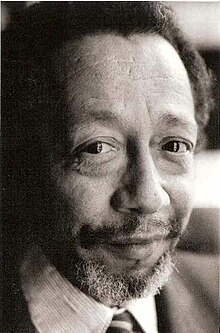Cab Kaye
| Cab Kaye | |
|---|---|

Photo Dixie Solleveld
|
|
| Background information | |
| Birth name | Nii-lante Augustus Kwamlah Quaye |
| Also known as | Cab Quaye, Cab Quay, Kwamlah Quaye, Kwamla Quaye, Nii Lante Quaye, Kab Kay |
| Born |
3 September 1921 London, UK |
| Origin | Camden, London, England |
| Died | 13 March 2000 (aged 78) Amsterdam, The Netherlands |
| Genres | Jazz, blues, bebop |
| Occupation(s) | Musician, composer, entertainer |
| Instruments | Vocals, drums, piano, guitar |
| Years active | 1936–1996 |
Nii-lante Augustus Kwamlah Quaye (3 September 1921 – 13 March 2000), better known as Cab Kaye, was an English jazz singer, pianist, band leader, entertainer, drummer, guitarist and songwriter of Ghanaian and Dutch descent. He was influenced by Billie Holiday and often accompanied himself on piano with a graceful rhythmic style. He combined blues, bebop, stride and scat with the music of his African and Ghanaian musical heritage.
Cab Kaye, also known as Cab Quay, Cab Quaye and Kwamlah Quaye, was born on St. Giles High Street in Camden, London to a musical family. His Ghanaian great-grandfather was an asafo warrior drummer and his grandfather, Henry Quaye, was an organist for the Methodist Mission church in the former Gold Coast, now called Ghana. Cab's mother, Doris Balderson, sang in English music halls and his father, Caleb Jonas Quaye (born 1895 in Accra, Ghana), performed under the name Ernest Mope Desmond as musician, band leader, pianist and percussionist. With his blues piano style, Caleb Jonas Quaye became popular around 1920 in London and Brighton with his band "The Five Musical Dragons" in Murray's Club with, among others, Arthur Briggs, Sidney Bechet and George "Bobo" Hines.
When Cab Kaye was only four months old, his father was killed in a railway accident in Blisworth, Northamptonshire, on 27 January 1922, on his way to perform in a concert. Cab, his mother and his sister Norma moved to Portsmouth, where a life insurance policy provided temporary financial support. Between the ages of nine and twelve he spent three years in hospital while a tumour in his neck was irradiated. British radiation therapy was still in its infancy, and Kaye's treatment was experimental. A permanent scar remained on the left side of his neck.
...
Wikipedia
